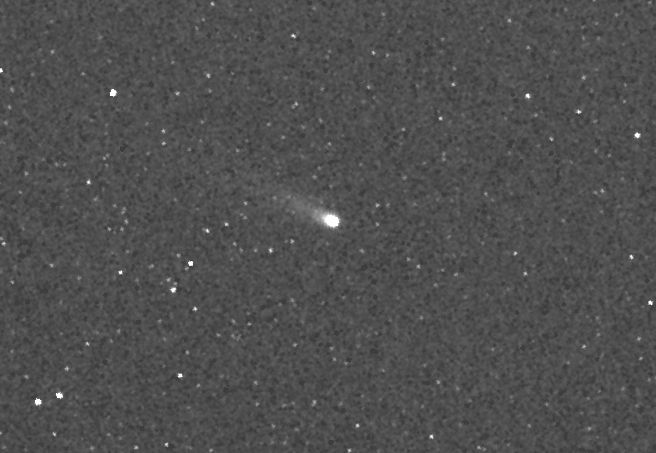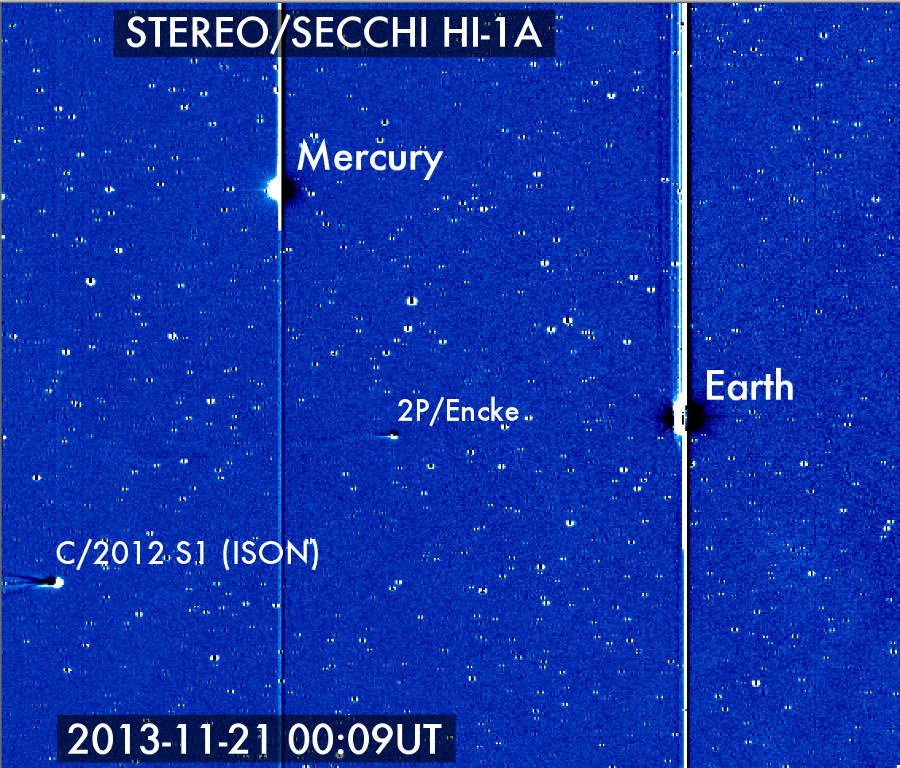
A NASA probe orbiting Mercury has returned new photos of Comet ISON, and a number of other spacecraft are all set to document the icy wanderer's much-anticipated solar flyby on Thursday (Nov. 28).
NASA's Messenger spacecraft snapped new images of Comet ISON on Nov. 19 as the icy object sped by Mercury at a distance of 22.5 million miles (36.2 million kilometers). Meanwhile, the agency's sun-studying Stereo-A probe captured its own ISON photo on Nov. 21, and a phalanx of other solar space observatories will watch the comet's close encounter with the sun on Thursday, which will bring it within just 730,000 miles (1.24 million km) of the solar surface.
Messenger has been watching ISON and another comet, Encke, for the last month, monitoring both of them with imagers and spectrometers. The spacecraft's observations offer a perspective unavailable from locations on Earth, potentially revealing new details about the comets' structure and composition, researchers said. [How to See Comet ISON in the Night Sky]
"Comet encounters were not considered when the Messenger mission was designed," Messenger principal investigator Sean Solomon, of Columbia University, said in a statement. "If Encke and ISON share a few of their secrets on the formation and evolution of the solar system, the Messenger team will be delighted with the scientific bonus."
While Messenger will continue observing Encke through early December, it will cease watching ISON on Tuesday (Nov. 26) because the comet will be too close to the sun, researchers said.
But several solar spacecraft will pick up where Messenger leaves off. Stereo-A, for example, has been observing Comet ISON since Nov. 21 and will continue watching through Friday (Nov. 29). Stereo-A's twin, Stereo-B, will chip in from Tuesday through Friday, and the SOHO spacecraft — a joint effort involving NASA and the European Space Agency — will eye ISON from Wednesday through Saturday (Nov. 27-30).
In addition, NASA's Solar Dynamics Observatory (SDO) will track the comet's solar close encounter on Thursday, as will Japan's Hinode probe.
Get the Space.com Newsletter
Breaking space news, the latest updates on rocket launches, skywatching events and more!

"All of these observatories will have different views. Stereo-B will be the only one that sees the comet transit across the face of the sun," NASA officials wrote in a statement on Friday (Nov. 22).
"In SDO's view, the comet will appear to travel above the sun, and the SDO instruments will point away from the center of the sun to get a better view for three hours on Nov. 28," they added. "In addition to learning more about the comet itself, these observations can make use of the comet as a tracer to show movement in the solar wind and solar atmosphere."
Comet ISON could put on a great show if it survives its daredevil dive on Thursday, shining brightly in the sky throughout early December, experts say. And the flyby has scientists excited, too. ISON is making its first trip through the inner solar system from the distant, icy Oort Cloud, so observing which gases get boiled off its surface can yield rare insights into the composition of a relatively pristine comet, researchers say.
Editor's note: If you snap an amazing picture of Comet ISON or any other night sky view that you'd like to share for a possible story or image gallery, send photos, comments and your name and location to managing editor Tariq Malik at spacephotos@space.com.
You can follow the latest Comet ISON news, photos and video on SPACE.com.
Follow Mike Wall on Twitter @michaeldwall and Google+. Follow us @Spacedotcom, Facebook or Google+. Originally published on SPACE.com.
Join our Space Forums to keep talking space on the latest missions, night sky and more! And if you have a news tip, correction or comment, let us know at: community@space.com.

Michael Wall is a Senior Space Writer with Space.com and joined the team in 2010. He primarily covers exoplanets, spaceflight and military space, but has been known to dabble in the space art beat. His book about the search for alien life, "Out There," was published on Nov. 13, 2018. Before becoming a science writer, Michael worked as a herpetologist and wildlife biologist. He has a Ph.D. in evolutionary biology from the University of Sydney, Australia, a bachelor's degree from the University of Arizona, and a graduate certificate in science writing from the University of California, Santa Cruz. To find out what his latest project is, you can follow Michael on Twitter.









